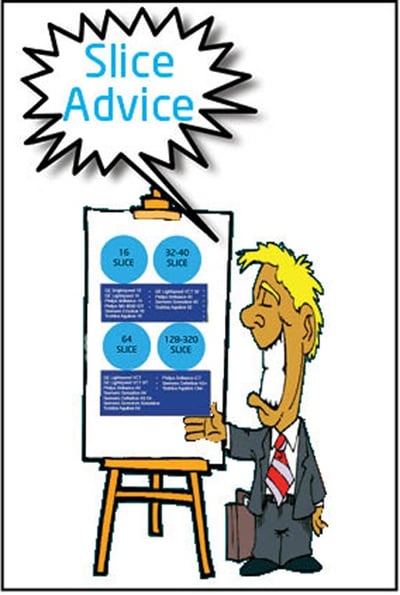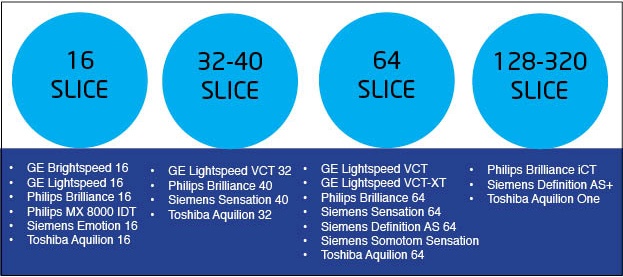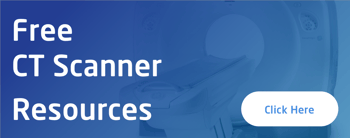Are you thinking about replacing your CT Scanner in order to meet increased demand? Are you considering  the addition of a new CT Scanner to offer a different imaging modality to your practice? Before you make a final decision, one of the most important considerations is the number of data slices you need—or think you need.
the addition of a new CT Scanner to offer a different imaging modality to your practice? Before you make a final decision, one of the most important considerations is the number of data slices you need—or think you need.
This is not a decision to be taken lightly. After all, CT Scanners are expensive to purchase, as well as to operate. A higher slice count reduces scan time and produces a higher picture resolution for some types of studies. However, for many practices and imaging centers, a lower slice count (which also generally comes with a lower price tag) is completely sufficient. Here is a handy guide that explains a CT Scanner’s slice count and most common uses:
4-slice CT: The good throughput and reasonable speed of a 4-slice system allows it to do well in a variety of environments. It’s ideal for a veterinarian or a low-volume imaging center. In might also be a great solution for urology practices or others that only use the CT Scanner one or two days per week.
16-slice CT: Right now, this is the sweet spot for higher-use facilities, where patient flow is steady or reduced scan time is a priority. If you will be using the CT Scan every day and have a fairly heavy patient load, this is probably the right one for you. It is a good fit in ERs and Urgent Care Centers, as well as Hospitals or high volume imaging centers. Here’s the good news: if you’re shopping for 16-slice CT Scanners right now, you’ll find incredible deals on the market.
32 to 40-slice CT: These generally provide a longer coverage per gantry rotation than 16 slice scanners, which results in shorter examination times and reduced likelihood of motion artifacts.
64-Slice CT: These scanners are really necessary in the world of cardiac, trauma, or very high volume critical care environments. The speed and sensitivity that comes with 64-slices allows for “freeze-frame” imaging, which minimizes the negative effects that heart and muscle motion have on picture quality. The high speed of the 64-slice CT is also helpful in trauma environments, where time is of the essence.
128-slice CT: This is most commonly found in cardiac or research institutions. It is the latest generation in a line of CT scanners and it’s revolutionizing non-invasive diagnosis. This machine can scan the whole body in seconds and provide incredibly sharp 3D images of any organ.
Wide bore scanners have bigger gantry aperture and maximum reconstruction field-of-view when compared with conventional scanners. The number of slices offered is dependent on the manufacturer. These are generally purchased for radiotherapy planning, as they allow greater flexibility for positioning the patient in the treatment position. However, they may also be considered for other applications where the increased aperture and field-of-view are beneficial. For example, it would be ideal for imaging bariatric, trauma and intensive care patients.
Once you’ve determined which slice count is right for you, here are some CT manufacturers/models to consider:

As always, you can experience extreme cost savings by purchasing a used or refurbished CT Scanner for your practice, while still getting the warranty and service contracts you want and need. For additional information or guidance in determining which used CT Scanner is right for you, talk to an expert—like Atlantis Worldwide.
Contact Jeff Weiss for more infomation at 212-366-9100 or jeffweiss@atlantisworldwide.com




